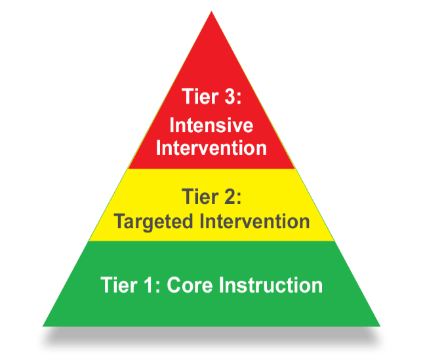MTSS systematically employs universal screening, progress monitoring, and data-based decision making to deliver academic, behavioral, and social-emotional instruction that addresses the needs of the whole child. In addition to the Tier 1 core curriculum, Tier 2 and Tier 3 level supports offer increasingly intensive instruction and intervention. Support ranges from supplemental targeted, small group interventions to intensive individualized support.
- Tier 1: Tier 1 is designed to meet the needs of most students through the delivery of research-based academic, behavioral, and social-emotional instruction.

- Tier 2: Some students will require more support to be successful with the core curriculum. For these students, supplemental Tier 2 instruction and interventions deliver evidence-based support targeted to specific skill deficits.
- Tier 3: A few students will require more intensive, individualized support in addition to the core curriculum. Tier 3 supports provide intensive individualized evidence-based interventions.
Tiered Delivery of Support
Tiered support is delivered through the systemic use of screening, progress monitoring, and data-based decision making.
- Universal Screening: Systematic screening is conducted to identify students who are at-risk for poor academic, behavioral, or social-emotional outcomes and who may need additional support.
- Progress-Monitoring: Student progress is used to assess student performance and rate of improvement. Progress monitoring is used to evaluate the effectiveness of instruction and interventions and evaluate the effectiveness of the program.
- Data-Based Decision Making: Implementation teams at the district, school, and student level use screening and progress monitoring data to make decisions about instruction and intervention delivery. Fidelity data are regularly reviewed to evaluate the accuracy of instruction and intervention.